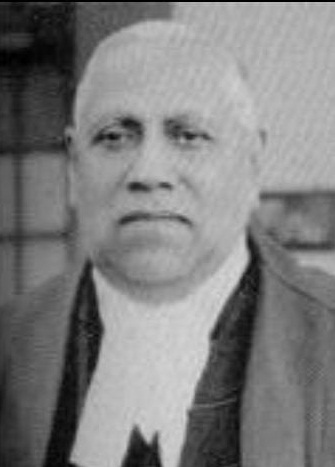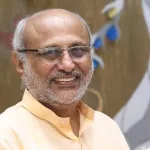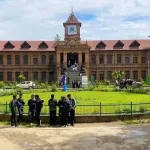135TH BIRTH ANNIVERSARY
The 135th birth anniversary of Mehr Chand Mahajan, who donned many hats falls on December 23, 2024. Who is Mehr Chand Mahajan? His role as Prime Minister of Jammu and Kashmir, Chief Justice of India, head of Punjab Border Commission and much more. Let’s discuss.
Mehr Chand Mahajan, an eminent Indian jurist and politician, was born on December 23, 1889, in the village of Tikka Nagrota in distict Kangra, Punjab Province—then British India now in Himachal Pradesh. His father Brij Lal was an advocate and was practicing in Dharamshala. Mehr Chand Mahajan studied Chemistry in Lahore and later switched to Law. He started practicing in Dharamshala for an year and shifted to Gurdaspur where he practiced for four years between 1914 and 1918. He then practiced law in Lahore from 1918 to 1943. He served as president of the High Court Association Lahore from 1938 to 1943. Mahajan later became judge of Punjab High Court during pre-independence. Mehr Chand Mahajan’s son Vikram Chand Mahajan was a politician and three time MP and Union Minister representing Kangra Parliamentary Constituency from Congress party between 1967 to 1971, 1972 to 1977, 1980 to 1984.
Prime Minister of Jammu and Kashmir
After National Conference govt assumed office in Jammu and Kashmir in 1996 and in commemoration of the country’s Golden Jubilee of Independence, the department of information headed by its Director KB Jandial took onerous project of publishing a book on 50 years in J&K. I was fortunate to receive one copy of this masterpiece from none other than the Director himself almost 26 years ago when I was working for a leading English daily.
The book, which mainly focuses on the 50 years journey of Jammu and Kashmir before and after the partition, apart from delving deep– from politics to partition to accession with India etc– slightly sheds light on Mehr Chand Mahajan who served as Prime Minister of Jammu and Kashmir around the period of Independence, partition of India and J&K’s accession with India.
RC Kak and Maj General Janak Singh had earlier served as Prime Ministers of Jammu and Kashmir. Before his appointment as Prime Minister of Jammu and Kashmir, Mahajan was a Judge in Punjab High Court during pre-independence era.
Though there are other books like Mehr Chand Mahajan’s own autobiography “Looking Back” and Vidhya Dhar Mahajan’s book titled ” Chief Justice Mehr Chand Mahajan” which gives insight on life, work and profile of Mehr Chand Mahajan and his contributions towards the boundary demarcation, legal field, politics and the society at large, the book released by J&K Government 26 years ago carries eyewitness account of horrors of partition from an eminent journalist Sati Sahni dealing with the period between June 3 and November 3, 1947–from the time Mountbatten Plan for Independence was announced and up to the day the Emergency administration was established in Jammu and Kashmir.
Sati Sahni writes, “Major General Janak Singh, who was made Prime Minister on August 11 was not able to gear up the administration to meet the explosive situation. The Maharaja replaced him on October 15, 1947 by Mr Mehr Chand Mahajan. The situation all along the Pakistani border had become warlike. Telegrams were exchanged between Kashmir Government and the Pakistani Government accusing each other of creating trouble for the other”. That Justice Mahajan is credited with having played a key role in the State’s accession to India becomes evident while going through the book.
“The Indian Government after receiving reports of Pakistani attack considered the fast developing situation and on October 25 sent Mr VP Menon, Secretary of the Ministry of States to Srinagar to take stock of the situation and report back. He met the Prime Minister Mr Mahajan and called on the Maharaja to leave for Jammu same evening along with his family in view of the enemy advance towards Srinagar. Mr Menon returned to New Delhi on October 26, along with Mr Mahajan. They conveyed to the ministers in New Delhi the desire of Maharaja Hari Singh to make his state part of Indian Dominion and seek assistance for defence of his state and its people. Same day both of them were flown to Jammu to complete the document of Instrument of Accession…” Sahni writes.
Justice Mahajan was also the Prime Minister of Jammu & Kashmir from October 15, 1947 to October 30, 1947 till Sheikh Mohd Abdullah replaced him on March 5, 1948. “The Maharaja did not do away with the Cabinet headed by the Prime Minister Mr Mehar Chand Mahajan. However, they did not function in the face of popular response to the Emergency Administration. On March 5, 1948, Sheikh Abdullah was made the Prime Minister”, Sahni writes.
Punjab boundary Commission
As on June 3, 1947, British declared independence under Mountbatten Plan. Sir Cyril Radcliff chaired two committees on division of India from Punjab and Bengal side. Whereas Radcliff was a lawyer from England with no previous knowledge or experience of cartography, Mehr Chand Mahajan was made head of boundary commission on Punjab border. Though Mahajan had studied in Lahore, practicing there and also serving as Judge of Lahore High Court, even then he seemed to be helpless in retaining Lahore for India because the four member commission–two from Indian National Congress (Mehr Chand Mahajan, Teja Singh from Indian National Congress and Din Mohd and Mohd Munir from Muslim League) were not ready to part with the historic cities like Amritsar and Lahore. It was Radcliff whose decision mattered the most.
Even then Mahajan’s involvement in the commission was marked by intense negotiations and debates over territorial claims. He represented India’s interests with great zeal, ensuring that the rights and aspirations of Indian citizens were safeguarded. His efforts were particularly significant in securing areas like Gurdaspur for India, which had strategic and symbolic importance.
Despite his best efforts, Mahajan was deeply troubled by the violence and displacement caused by the partition. He viewed the commission’s work as a necessary but painful step in the process of India’s independence, and he remained committed to mitigating its adverse effects on affected communities. The boundary award was announced on August 17, 1947 which resulted into deaths of a million people and displacement of over 12 million on both the sides.
Role towards Judiciary
Mahajan’s tenure as a judge of Supreme Court of India from 1948 to 1954 and later as Chief Justice of India from January 4, 1954 to December 22, 1954 was marked by several landmark judgments that have had a lasting impact on Indian jurisprudence. One of his most notable contributions was his focus on upholding fundamental rights. As a judge, he frequently emphasized the importance of balancing individual freedoms with societal welfare. His judgments often highlighted the principles of equity, justice, and good conscience, making him a key figure in shaping India’s post-independence legal framework.
One of his most impactful judgments was in State of Madras v. Champakam Dorairajan (1951).
This case dealt with the issue of caste-based reservations in educational institutions. Champakam Dorairajan, a Brahmin woman, challenged the State of Madras’ order that reserved seats in government colleges on the basis of caste, which restricted her admission opportunities.
Judgment:
The Supreme Court, with Mehr Chand Mahajan as part of the bench, struck down this reservation order, ruling that it violated Article 15(1) of the Indian Constitution, which prohibits discrimination on grounds of religion, race, caste, sex, or place of birth.
This judgment reaffirmed the constitutional principle of equality and ensured that no discriminatory practices could override fundamental rights. The judgment also exposed the need for affirmative action to uplift historically disadvantaged communities, leading to the First Amendment of the Indian Constitution (1951), which added Article 15(4), enabling the State to make special provisions for the advancement of socially and educationally backward classes.
Notable judgment on freedom of speech
Justice Mahajan’s significant contributions to the legal landscape in India regarding freedom of speech came through the landmark case of Brij Bhushan v. State of Delhi (1950). The case revolved around the pre-censorship order issued by the Delhi government against the magazine Organiser. The government sought to regulate the publication of material critical of Pakistan, following communal tensions post-Partition. The magazine challenged the restriction, claiming it infringed on their fundamental right to freedom of speech and expression under Article 19(1)(a) of the Indian Constitution.
Judgment:
The Supreme Court, with Justice Mehr Chand Mahajan as a part of the bench, struck down the pre-censorship order as unconstitutional, ruling that such restrictions were not in line with Article 19(1)(a) and could not be justified under the reasonable restrictions provided in Article 19(2).
The judgment was among the first to uphold freedom of speech as a fundamental right, ensuring the press’s autonomy and independence in a democratic setup. It clarified that censorship could only be imposed under specific circumstances mentioned in Article 19(2), such as concerns for public order, security, or morality, and pre-censorship was not permissible without a clear justification.
Mahajan Sabha of Faridabad in Haryana has been organizing functions to commemorate the birth anniversaries of this towering figure. This year—135th anniversary celebrations were also organized where life of Mehr Chand Mahajan was celebrated and homage paid to him. On the invitation of President of the Sabha Dr Akhil Mahajan, I too got the opportunity to speak a few words where I made a suggestion for raising demand for bestowing Bharat Ratan upon Mehr Chand Mahajan and some within the audience took to social media urging the government for the same. Mr Dipak Thukral and Satinder Duggal were among others speakers who threw light on life and personality of Mehr Chand Mahajan. This gesture of Bharat Ratna demand would be the best tribute to remember contributions of this great human being who donned many hats when the pre and post independent India was facing tough times.
(The Author is a Senior Journalist)








